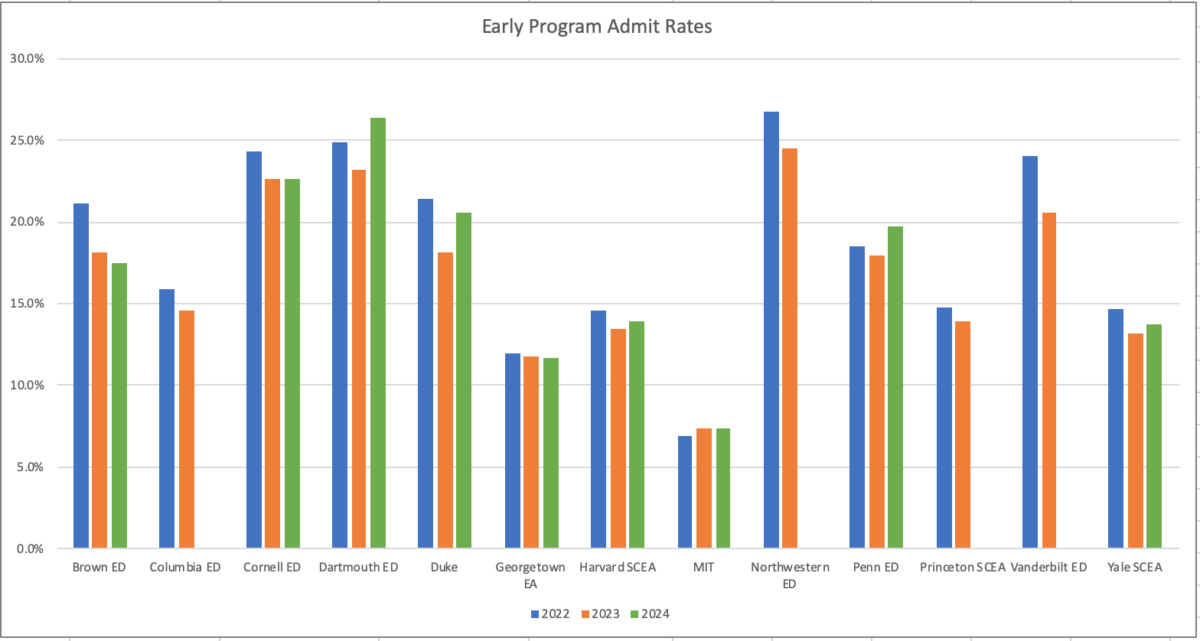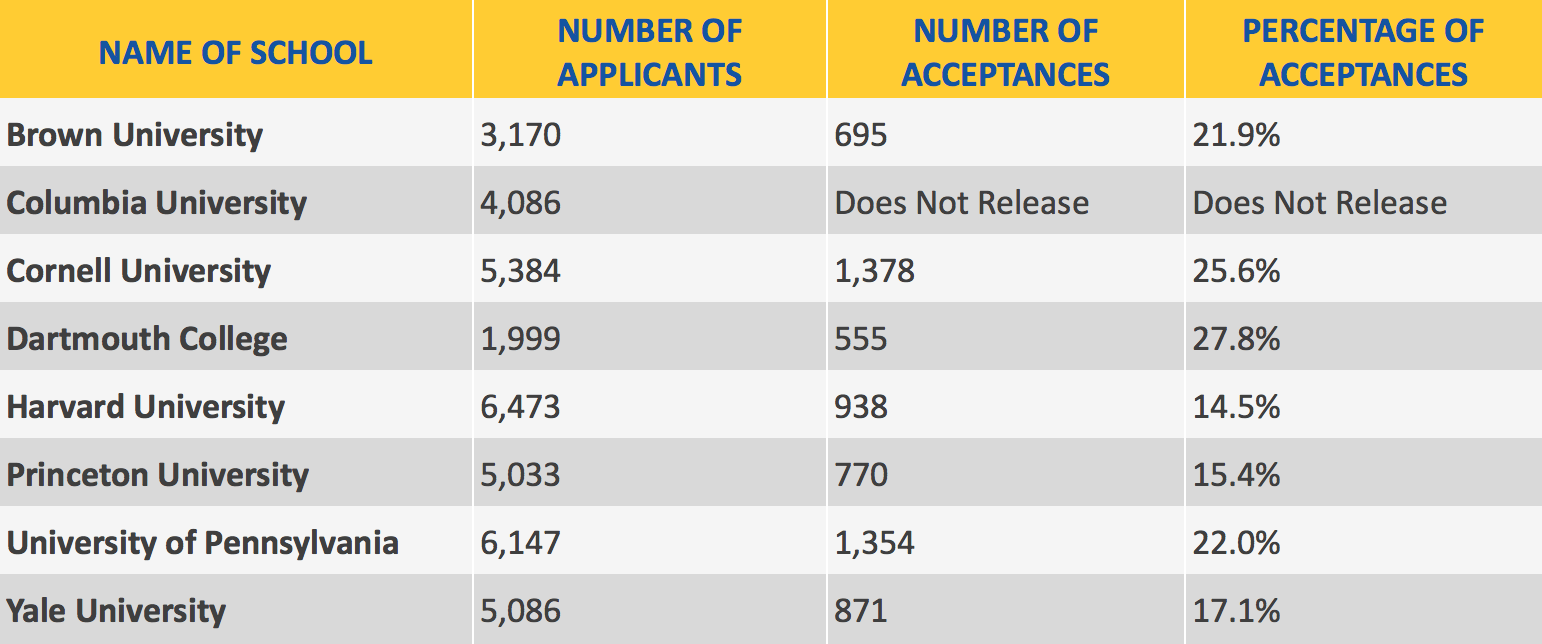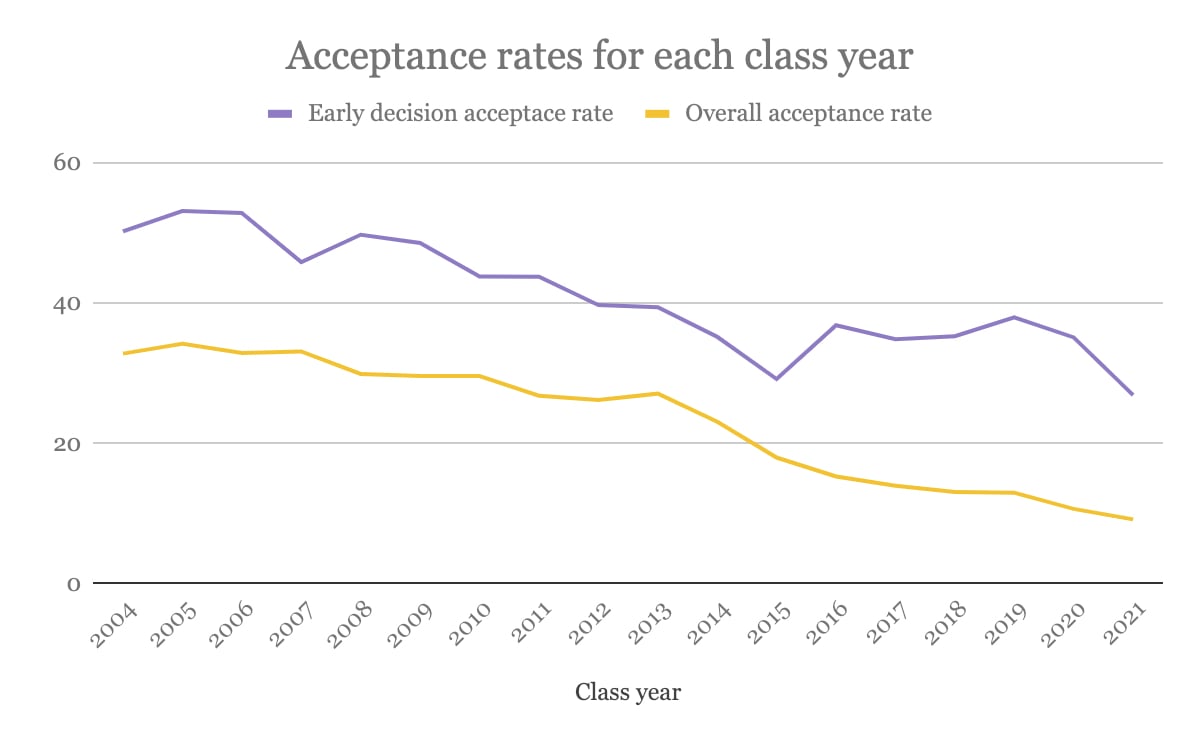The most intriguing twist on the SAT emphasis is applied at Georgetown, one of a handful of schools still offering nonbinding early action. Whereas Harvard knows that nearly all the students admitted EA will enroll, Georgetown knows that most of the academically strongest candidates it admits early will end up at Yale or Stanford if they get in. Georgetown sticks with EA in part because Charles Deacon, its dean of admissions, is a prominent critic of the increased use of binding programs and the sense of panic and scarcity they create among students.
Because colleges often highlight the average SAT scores of the students they admit, not just the ones who enroll, a policy like Georgetown's can make a school look better. Suppose a college needs to enroll 2,000 students in its incoming class. Suppose it receives roughly 12,000 applications each year in the regular admissions cycle—a realistic estimate for a prestigious, selective school. Suppose, finally, that its normal yield for students admitted in the regular cycle is 33 percent—that is, for each three it accepts, one will enroll. So to end up with 2,000 freshmen on registration day, a college relying purely on a regular admissions program would send "We are pleased to announce" letters to 6,000 applicants and hope that the usual 33 percent decided to enroll.
A regular-only admissions policy would thus mean that the college's selectivity rate—6,000 acceptances for 12,000 applicants—was an unselective-sounding 50 percent. Admission StandardsEliteApplicant CompetitionExtremeHow hard is it to get into Penn and can I get accepted? The school has a 8% acceptance rate ranking it #1 in Pennsylvania for lowest rate of acceptance. Last year, 3,740 out of 44,491 applicants were admitted making Penn an extremely competitive school to get into with a very low chance of acceptance – even for applicants with the highest scores and grades. Academically, it has exceptionally high requirements for admission test scores, generally admitting students who score in the top 4 percent. University of Pennsylvania typically accepts and attracts "A-" average high school students.
With over half of admitted students enrolling, acceptance by University of Pennsylvania is a prized outcome for many students. Most incoming freshmen graduated in the top ten percent of their high school class. Despite having the lowest acceptance rate in their school's history, so far, Penn has the highest acceptance rate among the Ivy League schools that released their data. On Tuesday, Dec. 12, Harvard University admitted just 964 students out of 6,630 applicants, an admission rate of just 14.5 percent to their early admissions program.
Earlier on Wednesday, Princeton University sent out early action admission offers to 799 lucky school seniors to the Class of 2022, out of a record 5,402 applications. Princeton's acceptance rate was a record low with only 14.7 percent of student accepted. The sheer increase in the number of applications received is the only reason for Penn's significantly smaller acceptance rate. More high school seniors are applying for early admission programs giving schools more quality applicants to choose from for their incoming class. This year Penn saw an increase of 9.5 percent from last year in the number of early decision applications they received, that number is 38 percent more from when the Class of 2018 applied in 2013.
For the Class of 2021, Penn received what was then a record 6,147 applications. If you're wondering how to get into UPenn, you're most likely interested in how difficult the process is. As mentioned before, although an 8% acceptance rate might seem low, it's relatively high when compared to other Ivy League schools. While it's true that among state colleges, this admissions rate is low, you have to consider it within the context of UPenn's prestige and world-class offerings. Fortunately, the university's admissions process provides you with plenty of opportunities to stand out from the competition and demonstrate why you deserve to attend this school. All-Ivy League schools have a set of supplemental essays applicants are required to complete in tandem with the standard application.
These prompts are designed to give admissions officers a better idea of who you are as an individual, what makes you unique, along other, more personal information about you. While the standard application covers mostly boring admission data such as your GPA and test scores, these supplemental essays are more open-ended in nature. It's paramount that students pen their responses carefully as they play an important role in determining whether or not you end up attending UPenn.
The Ivy League universities, including Harvard, Princeton, and Penn, have said they will delay announcing admissions decisions until April 6, about a week later than normal, to allow more time. A college's yield is the proportion of students offered admission who actually attend. If selectivity measures how frequently a college rejects students, yield measures how frequently students accept a college. In practice yield measures "takeaways"; if Georgetown gets a student who was also admitted to Duke, Boston College, and Northwestern, it scores a takeaway from each of the other schools. The higher the yield and the larger the number of takeaways, the more desirable the school is thought to be. If you want to know how to get into UPenn, it's helpful to learn more about how admitted students perform on some key academic indicators such as GPA and standardized test scores.
Since the UPenn acceptance rate is one of the most selective in the country – when compared to all colleges – it's no surprise that some of the most talented and brightest minds end up getting accepted. The advantage of applying Early Decision is that acceptance rates for ED applications are sometimes two to three times higher than the Regular Decision admission rates at the same schools. For instance, Northwestern's overall acceptance rate is only 9%, but its early decision rate is closer to 25%. Johns Hopkins University's jump is even bigger, from 9% to 31%. And the early decision rates at schools like Washington University in St. Louis, Emory University, and Tufts University are all multiple times the regular decision admission rate. Mid-December is early admission decision time and almost every other day anxious high school seniors await an email from the school of their dreams that will determine their future.
Ivy League school the University of Pennsylvania sent out 1,312 early decision offers of admission for the Class of 2022. This year Penn received a record number of applications, 7,074 students applied, and 15 percent more to the early decision program for the Class of 2021. As result, the college has its record lowest early admission rate in history at just 18.5 percent down from last year's 23.2 percent. It means having strong grades and SAT scores by the end of junior year and not thinking that one's record needs to be rounded off or enriched by senior-year performance.
It means that one's family has enough money to be unaffected by the possibility of competitive financial offers. It means that one is emotionally prepared to deal with a rejection if necessary and then to rush regular applications into the mail right away. The real question about the ED skew is whether the prospects for any given student differ depending on when he or she applies.
Last fall Christopher Avery, of Harvard's Kennedy School of Government, and several colleagues produced smoking-gun evidence that they do. The authors analyzed five years' worth of admissions records from fourteen selective colleges, involving a total of 500,000 applications, and interviewed 400 college students, sixty high school seniors, and thirty-five counselors. They found that at the ED schools an early application was worth as much in the competition for admission as scoring 100 extra points on the SAT. For instance, a student with a combined SAT score of 1400 to who applied early was as likely to be accepted as a regular-admission student scoring 1500 to 1600. An early student scoring 1200 to 1290 was more likely to be accepted than a regular student scoring 1300 to 1390. In ED programs students start their senior year ready to choose the one college they would most like to attend, and having already taken their SATs.
An early applicant is allowed to make only one ED application, and it is due in the beginning or the middle of November. The college has about a month to deliberate and responds by mid-December. If the answer is no, the student has two weeks to send out regular applications to schools on his or her backup list. If the answer is yes, the process is over, because by virtue of applying early, the student has promised to attend the college if accepted.
Mainly through counselors, who know when a student has been admitted ED and agree not to send official transcripts to other schools. Before we dive into some specific tips for increasing your chances of getting into UPenn, let's get a better idea of this university's overall admissions process. We'll take a look at some common questions amongst applicants that you might be wondering about yourself.
You'll be in a more advantageous position to nail the UPenn application once you're well-versed in what the admissions officers expect from applicants. Of the 56,333 students who applied to Penn's Class of 2025 in the early and regular rounds, 3,202 were admitted, leading to an overall acceptance rate of 5.68 percent. The 3,202 admitted students to the Class of 2025 included 1,194 students who were admitted through the early decision round.
The admission rate for the ED round was 15 percent out of 7,962 applicants. Last year, 42,205 students applied to Penn's Class of 2024 in the early and regular rounds and 3,404 were admitted, leading to an overall acceptance rate of 8.07 percent. Out of the total 3,404 admitted to the Class of 2024, 1,269 students were admitted through the early decision round. The admission rate for the ED round was 19.67 percent out of 6,453 applicants. For the Class of 2023, 44,960 students applied to in the early and regular rounds and 3,345 were admitted, leading to an overall acceptance rate of 7.44 percent.
Applications for binding early decision or more flexible early action programs jumped last year at schools including Harvard University and Brown University as anxious high-school seniors embarked on a chaotic admissions cycle. Schools ditched testing requirements, placed campus visits on hold because of the pandemic and are still sorting through whether students who deferred enrollment from the prior year would take away spots from the coming class. Now suppose that the college introduces an early-decision plan and admits 500 applicants, a quarter of the class, that way. It is very likely to receive at least as many total applications as before—say, 1,000 in the ED program and 11,000 regulars. But now it will have to send out only 5,000 acceptance letters—500 earlies plus 4,500 to bring in 1,500 regular students.
Therefore its selectivity will improve to 42 percent from the previous 50, and its yield will be 40 percent rather than the original 33, because all those admitted early will be obliged to enroll. The equivalent of a 100-point increase in SAT scores makes an enormous difference in an applicant's chances, especially for a mid-1400s candidate. Indeed, the difference is so important as to be a highly salable commodity. A gain of roughly 100 points is what The Princeton Review guarantees students who invest $500 and up in its test-prep courses. The Avery study's findings were the more striking because what admissions officers refer to as "hooked" applicants were excluded from the study. These are students given special consideration, and therefore likely to be admitted despite lower scores, because of "legacy" factors , specific athletic recruiting, or affirmative action.
In the regular decision process, which most students still follow, students spend the first semester of their senior year deciding on the group of colleges—four, six, thirty-three in one extreme case I heard about—to which they wish to apply. The colleges take three months to consider the applications, and respond by early April. Students have until May 1—the single deadline in this cycle adhered to by most colleges—to send a deposit to the school they want to attend and a "No, thanks" to any other that has accepted them. The colleges tally the returns and adjust the size of their incoming classes by accepting students on their waiting lists.
Each year the University of Pennsylvania receives approximately 23,000 undergraduate applications and admits about 4,000 students. Its 18% acceptance rate that makes it one of the most selective universities in the country. The Early Decision option is available for students who make UPenn their first choice and agree to matriculate, if accepted. There is a slightly higher acceptance rate for students who use this option.
If you're applying to more than one university , you'll notice that the vast majority of requirements overlap between all universities. However, you shouldn't take these similarities as an assumption that each school has the same application process. There are some important distinctions between universities that – no matter how small they may appear – can spell disaster for your application. Just because Harvard University requires a certain document or takes a particular activity into account, that doesn't mean the admissions officers at UPenn will do the same. I used The School's Online application portal to access the online form.
Portfolio, recommendation letters, resume, personal statement, research statement, academic transcripts and personalised test scores were required. The school consistently ranks among the top ten universities in the US offering a world standard, diverse array of academic programs, and a generous array of financial aid packages. University of Pennsylvania admissions are extremely selective with a low acceptance rate. Applicants even with above-average scores have very little chance of getting admitted.
Essay and LOR should be emphasized while making the application as a good essay and strong recommendation can set you apart in this tough competition. The admission decision are announced by Mid December for Early Decision applicants and by April 1 for Regular Decision applicants. Early Action is a non-binding commitment by Penn State to respond to applicants earlier in the admissions decision cycle. Applicants will still have until May 1 to pay their enrollment deposit or commit to Penn State. If you tend to stress out more than most and have been dreading the college admissions process, applying early action may be the best way to make your senior year of high school as enjoyable as possible. Penn's four undergraduate schools include a college of arts and sciences, a business school, an engineering school, and a school of nursing.
No matter which school or major students are enrolled in, Penn emphasizes that all undergraduate students receive a thorough foundation in the liberal arts. Many students take courses across all four undergraduate schools and choose from countless interdisciplinary minors and dual degrees. You can withdraw or change the status of your early application at any time before an admissions decision is reached. For some students, this might be withdrawing their application if they've had a change of heart, although they should be aware that this will be a red flag for colleges and likely decrease the applicant's chances in regular decision at that school. Joseph P. Allen, a boyish-looking man then in his mid-forties, became the director of admissions at the University of Southern California in 1993, moving from the same job at UC Santa Cruz. USC, like Penn, was a private institution with an unenviable reputation, because of its location in a dicey part of Los Angeles and because it was seen as a safety school for rich but unmotivated students.
Like Penn, USC waged an aggressive campaign to improve its image. By the late 1990s USC had nine times as many applicants as places; the average SAT score of incoming freshman classes had risen by 300 points; and the university had moved up in the U.S. Others who are left out are those whose parents wonder how they're going to pay for college, which is to say average Americans.
A student who applies under the regular system can compare loans, grants, and work-study offers from a variety of schools. A student who is accepted early decision has to take whatever aid the college offers. Colleges swear that in making need-based aid calculations they don't discriminate against early applicants. But even when that is the case, a student with only one offer on the table cannot know what might have been available elsewhere. Early Application - December Notification Under December Notification, an applicant may be notified that he or she has been granted or denied admission or that a final decision has been deferred until the late March notification date. Financial aid awards for those qualifying for financial assistance will normally be announced in full detail at the same time as the admission decisions.
An applicant receiving admission and an adequate financial award under the Early Decision Plan will be required to accept that offer of admission and withdraw all applications to other colleges or universities. All Ivy League institutions will honor any required commitment to matriculate that has been made to another college under this plan. AdmissionSight is a great resource that offers essay editing services to help make sure what you're submitting will play in your favor when admissions staff make their final decision.
As a college admissions specialist, AdmissionSight has helped countless students perfect their college supplemental essays for some of the best universities in the country, including UPenn. In 2019, UPenn's acceptance rate was 7.7% and in 2020, it was 8.07 percent, consistently making it one of the most competitive schools in the country. Of those admitted, 15% identify as first-generation, 54% are women, and 56% are U.S, citizens or permanent residents who identify as a person of color. Penn's yield rate—the percentage of accepted students who elect to enroll, divided by the total number of students who are admitted was 70% in 2019. The takeaway is that an exceptionally high number of those admitted to Penn ultimately choose to attend the university. Part of the explanation for this is that the majority of the class was brought aboard via binding early decision.
For comparison, elite schools such as Duke, Northwestern, Notre Dame, and Claremont McKenna all have yield rates under 60%. A whopping 56,333 applications were received by Penn for the Class of 2025, the largest applicant pool to date; only 3,202 individuals were accepted. Working out to 5.68% acceptance rate, this was the most selective year in the university's lengthy history. Applicants for the Classes of 2016 and 2017 saw admit rates in excess of 12%; the Class of 2018 is when the school's admit rate first dipped below 10%. The two years prior to the Class of 2025 cycle, 8.07% and 7.4% were accepted. Your child can apply to Penn via a binding early decision agreement by November 1st.
They'll receive an answer of accepted, deferred to the regular decision pool, or denied by mid-December. Penn admits roughly half of their incoming class through early decision, but the UPenn early decision acceptance rate is still low, around 15 percent. For the Class of 2021, 1,354 students were admitted through the early admissions process. Total early applications totaled 6,147, yielding an early acceptance rate of 22%.

























No comments:
Post a Comment
Note: Only a member of this blog may post a comment.